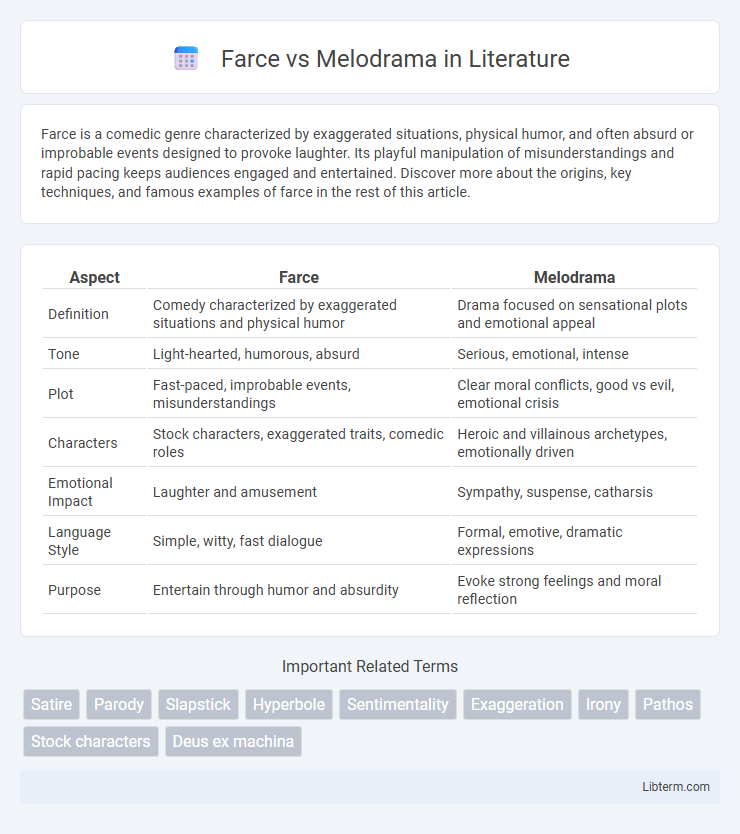Farce is a comedic genre characterized by exaggerated situations, physical humor, and often absurd or improbable events designed to provoke laughter. Its playful manipulation of misunderstandings and rapid pacing keeps audiences engaged and entertained. Discover more about the origins, key techniques, and famous examples of farce in the rest of this article.
Table of Comparison
| Aspect | Farce | Melodrama |
|---|---|---|
| Definition | Comedy characterized by exaggerated situations and physical humor | Drama focused on sensational plots and emotional appeal |
| Tone | Light-hearted, humorous, absurd | Serious, emotional, intense |
| Plot | Fast-paced, improbable events, misunderstandings | Clear moral conflicts, good vs evil, emotional crisis |
| Characters | Stock characters, exaggerated traits, comedic roles | Heroic and villainous archetypes, emotionally driven |
| Emotional Impact | Laughter and amusement | Sympathy, suspense, catharsis |
| Language Style | Simple, witty, fast dialogue | Formal, emotive, dramatic expressions |
| Purpose | Entertain through humor and absurdity | Evoke strong feelings and moral reflection |
Introduction to Farce and Melodrama
Farce and melodrama are theatrical genres distinguished by their thematic focus and emotional appeal. Farce relies on exaggerated situations, physical humor, and rapid pacing to entertain through absurdity and comedic chaos, emphasizing slapstick and improbable scenarios. Melodrama centers on heightened emotions, moral polarization, and sensational plots designed to evoke intense audience sympathy and clear distinctions between heroes and villains.
Defining Farce: Key Characteristics
Farce is a comedic genre characterized by exaggerated physical humor, improbable situations, and fast-paced action that aims to provoke laughter through absurdity and slapstick. It relies heavily on mistaken identities, misunderstandings, and ridiculous events, often featuring a simple, straightforward plot designed for maximum entertainment. Key characteristics include broad characters, exaggerated expressions, and a relentless sequence of comedic mishaps that escalate tension until a humorous resolution.
Understanding Melodrama: Essential Traits
Melodrama emphasizes exaggerated characters and sensational plots designed to evoke strong emotional responses, often featuring clear distinctions between heroes and villains. Its storytelling relies on moral polarization, heightened emotions, and dramatic situations that underscore themes of good versus evil. The essential traits include a strong narrative arc centered on conflict resolution, emotional appeal, and characters driven by passion or virtue.
Historical Origins and Development
Farce originated in medieval France during the 15th century as a short, comic interlude performed in vernacular French to entertain church audiences, emphasizing exaggerated situations and physical humor. Melodrama emerged in the late 18th century, combining spoken dialogue with music to heighten emotional impact, becoming popular in 19th-century theatres across Europe and America for its sentimental and moral narratives. The development of farce remained centered on rapid, absurd situations for comedic relief, while melodrama evolved to evoke strong emotional responses through clearly defined characters and dramatic plots.
Core Differences Between Farce and Melodrama
Farce emphasizes exaggerated, improbable situations and physical humor to provoke laughter, relying on rapid pacing and absurdity. Melodrama centers on emotional appeal with clear moral distinctions, featuring heightened conflicts and characters facing dramatic trials to evoke sympathy. The core difference lies in farce's comedic chaos versus melodrama's serious, sentimental storytelling.
Common Themes and Motifs
Farce and melodrama both explore exaggerated human emotions and situations but differ in tone and intent; farce emphasizes absurdity and slapstick humor, while melodrama highlights moral polarization and emotional appeal. Common themes in farce include mistaken identities, improbable coincidences, and chaotic misunderstandings, whereas melodrama often features themes of good versus evil, justice, and personal sacrifice. Motifs such as disguise and deception appear frequently in farce, whereas melodrama relies on motifs like heightened emotional expressions, dramatic music cues, and clear distinctions between heroes and villains.
Notable Examples in Theater and Film
Farce is exemplified by theatrical works such as Moliere's "The Imaginary Invalid" and films like "A Night at the Opera," where exaggerated situations and rapid pacing create comedic chaos. Melodrama is illustrated by plays like "The Woman in White" and movies such as "Gone with the Wind," emphasizing emotional appeals, clear moral distinctions, and sensational plot twists. Both genres thrive in theater and film by engaging audiences through heightened situations but differ fundamentally in tone and purpose.
Influence on Modern Entertainment
Farce and melodrama have significantly shaped modern entertainment by influencing genres such as sitcoms, soap operas, and superhero films, with farce contributing to exaggerated comedic timing and absurd situations while melodrama emphasizes emotional intensity and moral polarization. Television shows like "The Office" utilize farcical elements to create humor through awkward social interactions and slapstick scenarios. Melodramatic storytelling is prominent in series like "Grey's Anatomy," where heightened emotional conflicts and dramatic tension engage viewers, demonstrating their enduring impact on narrative structures and character development in contemporary media.
Audience Reactions and Emotional Impact
Farce provokes intense laughter through exaggerated situations and rapid pacing, eliciting a sense of chaotic amusement that engages audiences by overwhelming their expectations with absurdity. Melodrama appeals to the audience's emotions by highlighting moral polarization and heightened characters, generating strong feelings of sympathy, anger, or sadness that invite viewers to emotionally invest in the protagonist's struggles. Both genres manipulate emotional responses effectively, with farce focusing on humor and disbelief, while melodrama drives emotional catharsis through dramatic tension.
Choosing Between Farce and Melodrama
Choosing between farce and melodrama depends on the desired emotional impact and narrative style. Farce emphasizes exaggerated, improbable situations and slapstick comedy to provoke laughter, while melodrama focuses on heightened emotions and moral polarization to evoke sympathy and tension. Selecting the appropriate genre hinges on whether the goal is to entertain through humor and absurdity or to engage audiences emotionally through dramatic plotlines and character conflicts.
Farce Infographic

 libterm.com
libterm.com